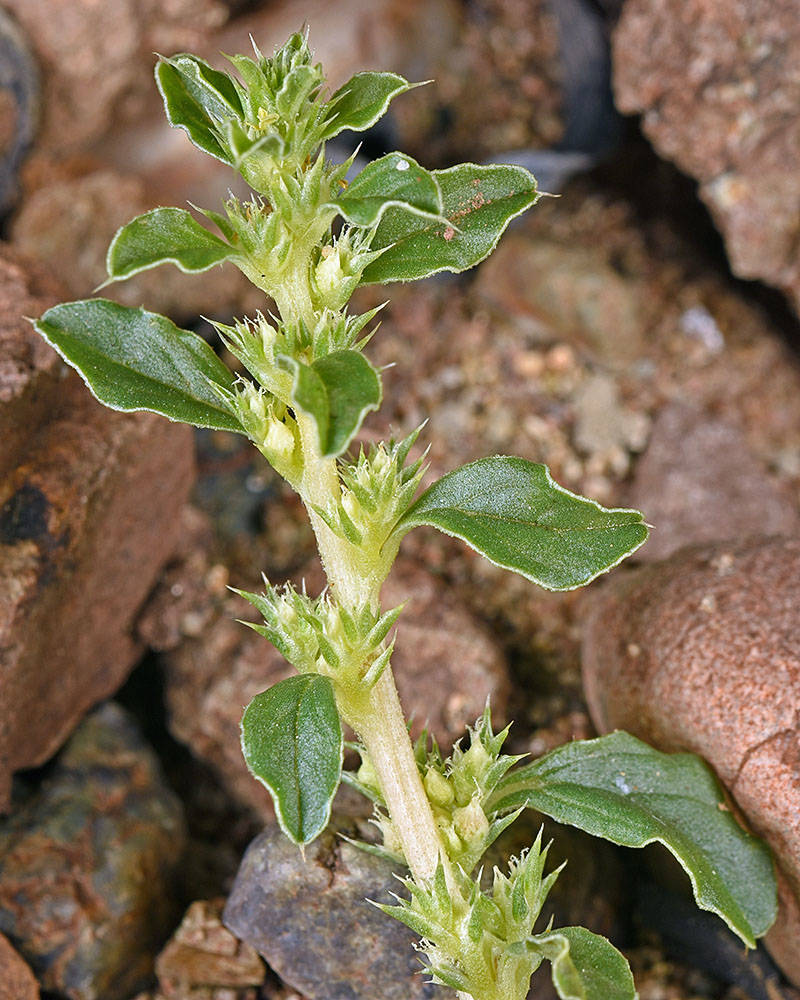Amaranthus hybridus
Amaranthus californicus
slender pigweed, slim amaranth
California amaranth
erect, branched or not, 3–12(20) dm, green or red.
prostrate; much branched and mat-forming, 1–5 dm, often whitish.
blades rhombic-ovate to widely lanceolate; (2)4–12(15) cm, bases wedge-shaped;
margins entire; plane;
tips acute to obtuse;
midveins extending to a spine;
petioles 1–5(10) cm.
blades oblong, obovate, or oblanceolate, 3–20 mm, bases wedge-shaped;
margins entire; plane; flat to sometimes undulate;
midveins extending to a spine;
tips rounded to subacute;
petioles 2–6(8)mm; ? ½ as long as blade.
terminal and axillary, tightly clustered; lax and nodding; dull green to red, villous;
bracts 2–4 mm;
midveins extending to a spine.
axillary clusters of flowers, staminate and pistillate flowers intermixed;
bracts small and inconspicuous, 1–2 mm.
perianth segments 5, mostly similar in staminate and pistillate flowers; erect, not overlapping or reflexed, linear to lance-oblong;
midveins extending to spine;
tips acute.
generally at inflorescence tips;
perianth segments of nearly equal length, 2–3 mm;
stamens 5.
perianth segments (2)3; equal to subequal, 1–1.5 mm;
stamens 3.
perianth segments of equal length or 1 slightly longer, 1.5–2 mm;
styles 3; erect.
perianth segments 1–3, unequal, only 1 well developed, 1–1.2 mm;
styles 3; erect.
ovoid, 1.5–2.2 mm, rugose at tips; smooth below; dehiscence circumscissile.
subglobose, 1–1.2 mm; smooth, wrinkled near tips; dehiscence irregular to circumscissile.
lenticular, widely orbicular to rounded, 1–1.4 mm, red-brown to black; shiny.
lenticular, obovate, 0.7–1 mm, dark red-brown; shiny.
=32.
Amaranthus hybridus
Amaranthus californicus
Disturbed areas, streambanks, roadsides, fields. Flowering May–Oct. 0–700 m. Casc, Owy, Sisk, WV. CA, ID, NV, WA; throughout North America; scattered worldwide. Native?
Amaranthus hybridus has been known to hybridize with A. retroflexus.
Mud flats, dry ponds, ditches, gravel bars, disturbed areas. Flowering Jun–Sep. 50–1500 m. BR, BW, Owy, Sisk. CA, ID, NV, WA; scattered in western North America. Native.
Bridget Chipman
Bridget Chipman
- Local floras:
CA,
OR,
WA
- Local Web sites:
CalFlora,
CalPhotos,
Flora NW,
PNW Herbaria
WildflowerSearch
iNaturalist (observations)
USDA Plants Database
- LBJ Wildflower Center
- SEINet
- Plants of the World Online
- Encyclopedia of Life
- Wikipedia
- Google Image Search
- Local floras:
CA,
OR,
WA
- Local Web sites:
CalFlora,
CalPhotos,
Flora NW,
PNW Herbaria
WildflowerSearch
iNaturalist (observations)
USDA Plants Database
- LBJ Wildflower Center
- SEINet
- Plants of the World Online
- Encyclopedia of Life
- Wikipedia
- Google Image Search




